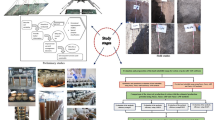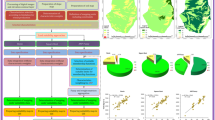Abstract
The objective of this article is to apply fuzzy set and interpolation techniques for land suitability evaluation for maize in Northern Ghana. Land suitability indices were computed at point observations using the Semantic Import (SI) model, whereas spatial interpolation was carried out by block kriging. Interpolated land suitability shows a high correlation (R 2 = 0.87) with observed maize yield at the village level. This indicates that land suitability is closely related to maize yield in the study area. Membership functions were further used to assess the degree of limitation of land characteristics to maize. Sixty percent of the data has membership functions ranging from 0.23 for ECEC to 1.00 for drainage. ECEC, organic C, and clay are the major constraints to maize yield. The use of the fuzzy technique is helpful for land suitability evaluation, especially in applications in which subtle differences in soil quality are of a major interest. Furthermore, the use of kriging that exploits spatial variability of data is useful in producing continuous land suitability maps and in estimating uncertainties associated with predicted land suitability indices.







Similar content being viewed by others
Literature Cited
Boogaard, H. L., C. A. van Diepen, R. P. Rötter, J. M. C. A. Cabrera, and H. H. van Laar. 1998. User’s guide for the WOFOST 7.1 crop growth simulation model and WOFOST Control Center 1.5. Technical Document 52. DLO-Winand Staring Centre, Wageningen, The Netherlands 144 pp.
Braimoh, A. K., and P. L. G. Vlek. 2004. Impacts of land-cover change on soil properties in Northern Ghanna, Land degradation and Development,, 15: 65–74
P. A. Burrough (1989) ArticleTitleFuzzy mathematical methods for soil survey and land evaluation Journal of Soil Science 40 477–492
P. A. Burrough R. A. McDonnell (2000) Principles of geographical information systems Oxford University Press New York
P. A. Burrough R. A. McMillian W. Van Deursen (1992) ArticleTitleFuzzy classification methods for determining land suitability from soil profile observation and topography Journal of Soil Science 43 193–210
P. A. Burrough P. F. M. van Gaans R. Hootsmans (1997) ArticleTitleContinuous classification in soil survey: spatial correlation, confusion and boundaries Geoderma 77 115–135 Occurrence Handle10.1016/S0016-7061(97)00018-9
J. P. Chilès P. Delfiner (1999) Geostatistics: Modeling spatial uncertainty Wiley–Interscience New York
CIMMYT. 1988. Maize production regions in the developing countries. International Maize and Wheat Improvement Center (CIMMYT), El Batan, Mexico.
H Cui A. Stein D. E. Myers (1995) ArticleTitleExtension of spatial information, Bayesian kriging and updating of prior variogram parameters Environmetrics 6 373–384
D. A. Davidson S. P. Theocharopoulos R. J. Bloksma (1994) ArticleTitleA land evaluation project in Greece using GIS and based on Boolean and fuzzy set methodologies International Journal of Geographic Information Systems 8 IssueID4 369–384
D. Dent A. Young (1981) Soil survey and land evaluation George Allen and Unwin Limited London
FAO. 1976. A framework for land evaluation. Soils Bulletin 32. FAO, Rome, 72 p.
FAO. 1983. Guidelines: Land evaluation for rainfed agriculture. Soils Bulletin 52. FAO, Rome, 237 pp.
Fugger, W.-D. 1999. Evaluation of potential indicators for soil quality in Savanna soils in Northern Ghana. Ph.D. thesis, Georg-August University, Göttingen.
R. Groenemans E. van Ranst E. Kerre (1997) ArticleTitleFuzzy relational calculus in land evaluation Geoderma 77 283–298 Occurrence Handle10.1016/S0016-7061(97)00026-8
A. A. Klingebiel P. H. Montgomery (1961) Land capability classification. Soil Conservation Service Handbook 210 U.S. Department of Agriculture Washington, DC
R. M. Lark H. C. Bolam (1997) ArticleTitleUncertainty in prediction and interpretation of spatially variable data on soils Geoderma 77 263–282 Occurrence Handle10.1016/S0016-7061(97)00025-6
A. B. McBratney I. O. A. Odeh (1997) ArticleTitleApplication of fuzzy sets in soil science: Fuzzy logic, fuzzy measurement and fuzzy decisions Geoderma 77 85–113 Occurrence Handle10.1016/S0016-7061(97)00017-7
A. O. Ogunkunle (1993) ArticleTitleSoil in land suitability evaluation: an example with oil palm in Nigeria Soil Use and Management 9 37–42
InstitutionalAuthorNameOverseas Development Institute (1999) Rethinking natural resources degradation in semi-arid sub-Saharan Africa: The case of semi-arid Ghana ODI Rural Policy and Environment Group London, UK
D. G. Rossiter (1996) ArticleTitleA theoretical framework for land evaluation Geoderma 72 165–190 Occurrence Handle10.1016/0016-7061(96)00031-6
A. Runge-Metzger L. Diehl (1993) Farm household systems in Northern Ghana Verlag Josef Margraf Weikersheim, Germany
Sankoh, O.A. Braimoh, A. K., Kamara, S. I. (2001) “Spatial data analysis and land evaluation procedures for community development in sub-Saharan Africa” In: Community Development on Sth-Saharm, Africa. Kokor, J. Y., Kroës (eds.) University of Dortmund SPRING Research Series 31: 85–97
Soil Survey Staff. 1994. Keys to soil taxonomy 7th ed. U.S. Department of Agriculture, Natural Resources Conservation Service, Washington, DC, 644 pp.
A. Stein (1998) ArticleTitleAnalysis of space-time variability in agriculture and the environment with geostatistics Statistica Neerlandica 52 IssueID1 18–41 Occurrence Handle10.1111/1467-9574.00066
Storie, R. E. 1933. An index for rating the agricultural value of soils. California Agricultural Experimental Station Bulletin 556, University of California, Berkley
C. Sys (1985) Land evaluation State University of Ghent Ghent; The Netherlands
H. Tang E. Van Ranst (1992) ArticleTitleTesting of fuzzy set theory in land suitability assessment for rainfed maize production Pedologie 17 129–147
Triantafilis, J., W. T. Ward, and A. B. McBratney. 2001. Land suitability assessment in the Namoi Valley of Australia, using a continuous model, Amsterdam Journal of Soil Research 39: 273–290
Van Lanen, H. A. 1991. Qualitative and quantitative physical land evaluation: An operational approach. Ph.D. thesis. Agricultural University Wageningen, The Netherlands.
E. Van Ranst H. Tang R. Groenemans S. Sinthurahat (1996) ArticleTitleApplication of fuzzy logic to land suitability for rubber production in peninsular Thailand Geoderma 70 1–19 Occurrence Handle10.1016/0016-7061(95)00061-5
L. A. Zadeh (1965) ArticleTitleFuzzy sets Information and Control 8 338–353
Zhang, L. A. 1989. A Land suitability evaluation system for specific rural purposes in New South Wales. Ph.D. thesis, The University of Sydney, NSW, Australia.
Acknowledgments
The German Federal Ministry for Education and Research and the Ministry for Schools, Science and Research of Northrhine Westphalia provided funding for the GLOWA project. The corresponding author also thanks the German Academic Exchange Services (DAAD) for funding his research studies. We sincerely appreciate the comments of Ayo Ogunkunle, Alex McBratney, and Anita Veihe on an earlier draft of this manuscript.
Author information
Authors and Affiliations
Corresponding author
Additional information
Published online
Rights and permissions
About this article
Cite this article
Braimoh, A., Vlek, P. & Stein, A. Land Evaluation for Maize Based on Fuzzy Set and Interpolation. Environmental Management 33, 226–238 (2004). https://doi.org/10.1007/s00267-003-0171-6
Published:
Issue Date:
DOI: https://doi.org/10.1007/s00267-003-0171-6




